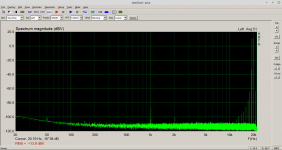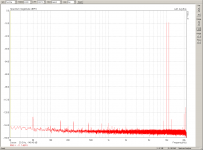The Purifi side bands are down -120dB with this test. How about with your friends PA5 amp?Meaningful by whose standard? Spectrum of music has high frequencies massively dropping in level. No way dual high frequency tones ever appear in music. They are at least 40 to 50 dB down. You don't have to justify tests that you run. I do. It is trivial to run such a test on AP and I have indeed run it on occasion. The fact that I can't defend it with a straight face is why I don't run it. Here are the results for example on Benchmark AHB2:

Reduce those sidebands by 40 to 50 dB and they sink well below noise floor. So you don't learn anything from it.
That’s a pretty good offer that they gave you special permission to buy one of their products in the open market. What’s it take to get into that club? Can’t anyone do that? Or do you mean if you do so you won’t breech the contract?There is always a possibility of this but Topping once made an offer that I can buy any of the gear they have tested in the open market to confirm that they are not gaming the system. From time to time members send me addition units to test and I am happy to do that in this case. So let's organize it on ASR.
And if you were in Kimura-san's team, for sure our paths may have crossed!
Last edited:
So, you suggest changing an amp before testing it? Nuts.I do not think that the measurements between a class D amp and Ab is comparable ... Beyond 20k
The inductors and filter outputs of classD amplifiers are responsible for removing all unwanted Hamonics and the modulation carrier of the amplifier.
Or measure the amp without an output filter ...east that's my point of view ...
//
<snip>Meaningful by whose standard? Spectrum of music has high frequencies massively dropping in level. No way dual high frequency tones ever appear in music. They are at least 40 to 50 dB down. You don't have to justify tests that you run. ...
But your site is a scientific based site and not a listening session one - right? And You have to admit that the 18/19 test is a quite hard one and must be said to be somewhat "industry standard" - no?
//
Hahaha ! Already saw that show, not a good one. Can't recommand it...Time to get out the popcorn (at 9:00 AM here ;-)
No doubt this is a pretty hard test. But I agree with Amir that is beyond the range of audibility. So - nice to have - but not really important for audio applications imho.<snip>
And You have to admit that the 18/19 test is a quite hard one and must be said to be somewhat "industry standard" - no?
//
Besides I agree that a bleeding edge class-D amp will loose compared to a bleeding edge linear AB amp in terms of noise, slew-rate and hi-frequency distortion. But with TPA3251 and some post-filter feedback the only audible difference is the residual noise level - not too bad at all - but there is about 10-20dB headroom for improvement.
Last edited:
If that’s the case please share a class A/B amp with a better 18+19k IMD result than thisNo doubt this is a pretty hard test. But I agree with Amir that is beyond the range of audibility. So - nice to have - but not really important imho.
Besides I agree that a bleeding edge class-D amp will loose compared to a bleeding edge linear AB amp in terms of noise, slew-rate and hi-frequency distortion. But with TPA3251 and some post-filter feedback the only thing that could nag me is the residual noise level - not too bad at all - but there is about 10-20dB headroom for improvement.
It’s the Purifi 1ET400A class D module. You’ll need to update your database to include today‘s class D amps.It is a pity you did not specify your EUT. And I can only refer to the linear/class-D-amps I measured.
Thank you for your reply. I admire Bruno Putzeys work - but this is DIY - so my reference are DIY amps I can afford.It’s the Purifi 1ET400A class D module. You’ll need to update your database to include today‘s class D amps.
You'll need to update your rude attitude of communication.
Last edited:
There’s been a DIY thread on this amplifier for 2 years now. Where have you been?Thank you for your reply. I admire Bruno Putzeys work - but this is DIY - so my reference are DIY amps I can afford.
You'll need to update your rude style of communication.
https://www.diyaudio.com/community/threads/brainstorming-purifi-1et400a-amps.347137/
Try not introducing yourself like this and you might get a warmer tone.
“Sorry but I cannot discover any contribution to DIY by you. And your claims to be that super-dupa audio guru are not entertaining at all.”
“So what? If you want to impress me, show your own designs.”
1:1 - and btw, this forum is not the center of my life. I do not read all threads, and I forget a lot meanwhile.
The IMD debate gave me a kick to do some IMD measurements of my own. Using my laptop with ARTA, an EMU-tracker pre USB-Interface, a 30V bench supply and a 4 Ohm dummy resistor I tested my TPA3251 prototype pcb module. The 1kHz peak amounts to -88.1dBV which results in a distortion level of -101.9dB below 5W/4 Ohms. Estimated accuracy is within +-3dB. Just to show an example of a real DIY solution.
The IMD debate gave me a kick to do some IMD measurements of my own. Using my laptop with ARTA, an EMU-tracker pre USB-Interface, a 30V bench supply and a 4 Ohm dummy resistor I tested my TPA3251 prototype pcb module. The 1kHz peak amounts to -88.1dBV which results in a distortion level of -101.9dB below 5W/4 Ohms. Estimated accuracy is within +-3dB. Just to show an example of a real DIY solution.
Attachments
Looks to me like the side bands are about -72dB below in the high frequencies. 48dB worse than the Purifi. And slightly worse than the $68 Icepower 100AS2 module1:1 - and btw, this forum is not the center of my life. I do not read all threads, and I forget a lot meanwhile.
The IMD debate gave me a kick to do some IMD measurements of my own. Using my laptop with ARTA, an EMU-tracker pre USB-Interface, a 30V bench supply and a 4 Ohm dummy resistor I tested my TPA3251 prototype pcb module. The 1kHz peak amounts to -88.1dBV which results in a distortion level of -101.9dB below 5W/4 Ohms. Estimated accuracy is within +-3dB. Just to show an example of a real DIY solution.
Last edited:
Not 19/20 but 10/11. 120dB down from the carrier. 6 years ago. Today I could do probably better.If that’s the case please share a class A/B amp with a better 18+19k IMD result than this
View attachment 1007268
Attachments
What is the power output at 0dBFS?Not 19/20 but 10/11. 120dB down from the carrier. 6 years ago. Today I could do probably better.
The CCIF IMD method is described in document no. 11 of the Commission Mixte, CCIF/UIR, March 1937, issued by the International Telephonic Consultative Committee (CCIF). CCIF no longer exists as an organization, having become the ITU-R division of the International Telecommunications Union (ITU). This method is also referred to as IMD (ITU-R).
The CCIF stimulus is two equal-level high-frequency tones f1 and f2, centered around a frequency called the mean frequency, (f1+f2)/2. The tones are separated by a frequency offset called the difference frequency. The two tones intermodulate in a distorting DUT to produce sum and difference frequencies.
For analysis CCIF selectively measures the 2nd and 3rd order intermodulation products, combines their values arithmetically and provides a result that is the ratio of the sum of the products to a reference voltage defined as 2x the voltage of f2 (effectively, the sum of f1 and f2). In the APx500 implementation, the 4th and 5th order products are also measured and reported in the distortion product view.
Because the stimulus tones are high in frequency, CCIF is a useful measurement for observing distortion in devices that exhibit distortion that rises with frequency. Since the tones by default are only 80 Hz apart, much of the energy contained in the distortion products will fall near or below the stimulus tones. This makes CCIF a good choice for measuring distortion at higher frequencies in band limited devices, where harmonic distortion products from high-frequency stimulus tones would fall out of band.
CCIF measurements are made in the same way as DFD measurements, differing only in amplitude calibration. CCIF results are expressed as values 6.02 dB higher than DFD.
https://www.ap.com/technical-library/more-about-imd/
The CCIF stimulus is two equal-level high-frequency tones f1 and f2, centered around a frequency called the mean frequency, (f1+f2)/2. The tones are separated by a frequency offset called the difference frequency. The two tones intermodulate in a distorting DUT to produce sum and difference frequencies.
For analysis CCIF selectively measures the 2nd and 3rd order intermodulation products, combines their values arithmetically and provides a result that is the ratio of the sum of the products to a reference voltage defined as 2x the voltage of f2 (effectively, the sum of f1 and f2). In the APx500 implementation, the 4th and 5th order products are also measured and reported in the distortion product view.
Because the stimulus tones are high in frequency, CCIF is a useful measurement for observing distortion in devices that exhibit distortion that rises with frequency. Since the tones by default are only 80 Hz apart, much of the energy contained in the distortion products will fall near or below the stimulus tones. This makes CCIF a good choice for measuring distortion at higher frequencies in band limited devices, where harmonic distortion products from high-frequency stimulus tones would fall out of band.
CCIF measurements are made in the same way as DFD measurements, differing only in amplitude calibration. CCIF results are expressed as values 6.02 dB higher than DFD.
https://www.ap.com/technical-library/more-about-imd/
Certainly a TPA3251 cannot compete with the purify, did you expect something different?Looks to me like the side bands are about -72dB below in the high frequencies. 48dB worse than the Purifi. And slightly worse than the $68 Icepower 100AS2 module
View attachment 1007325
- Home
- Amplifiers
- Class D
- Topping PA5 (TPA325X) : Is a modification worth it? ?

